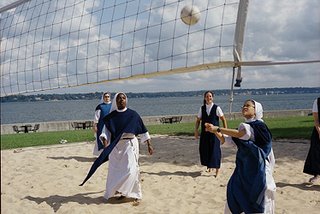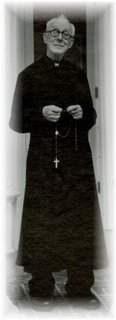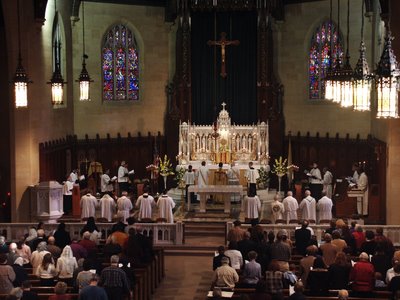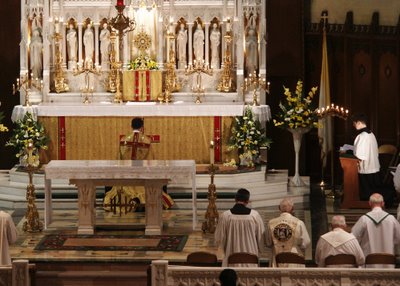If you are a woman looking for a religious order, you may be trying to find various orders via the web. There are several ways of doing this, such as using google and searching for "traditional nuns". There is one danger in this and I fell into the trap inadvertently some months ago before someone pointed out my error. You can stumble upon a traditional order which is schismatic and not in communion with Rome. It will have all the appearances of being Catholic, and even call itself Catholic. It may even say that it is in communion with the "current pope". However, by not naming him you don't know if that is Pope Benedict XVI, or "Pope" Michael. I always look for links to the Vatican and at other links within new sites that I discover. When you stumble upon a schismatic site, pray for them and move on.
One other thing is that a habit and traditional community in communion with Rome is no guarantee that it is solid in its understanding and application of religious life. If you see a significant emphasis on psychology, you may want to do a little more probing before jumping in. Find out if there is adoration and how they feel about Marian devotion, for example. Now, you should expect most any community to put you through an initial pyschological examination. However, you should not see a huge emphasis on pyschology in religious life, and especially in formation, as opposed to solid Catholic philosophy and theology. If catechetics is part of the program that is a plus because in today's society, most of us for the last 40 years have been very poorly catechized. How can one study theology without solid grounding in catechetics, as in the CCC? If you are even pondering religious or priestly life, you should have your nose in the CCC every evening and learn it like the back of your hand. Should someone try to convince you that Jesus did not multiply all the loaves of bread, and fish (indirectly challenging his divinity), you will know you are being sold a bad bill of goods.
You might also ask what scriptural exegetes, theologians & philosophers they include in their studies. Is it Ratzinger, von Hildebrand, John Hardon? Or, is it
Richard McBrien,
Raymond Brown, &
Karl Rahner.
On the other extreme, sometimes upon searching you will find orders with traditional sounding names, then wind up in the midst of a social justice website with an emphasis on recycling and saving trees. Like with some habited communities, you will find fans of McBrien and company, but probably in a greater percentage. The emphasis on pyschology, feelings and experience is likely to dominate. On some of these sites you may find many practices affiliated with the new age, such as "
enneagrams".
This is not to say that all non-traditional orders are bad. There are many women who do not wear traditional habits who work tirelessly in hospitals, with the poor, as missionaries, and other situations. I know for a fact there are such nuns in these orders whom you will find have a Marian and Eucharistic devotion, among those who do not. Hence, we can't judge individual sisters from these communities because we simply don't know. Likewise, when you stumble upon something disturbing among some community websites, pray for these sisters.
One thing you may want to ponder is whether you want a community that will support what you feel in your heart to be the proper path in religious life, or whether you believe you are strong enough to hold on to your values amidst a community which seems disoriented religiously. In other words, in some communities you will feel out of place if you have a devotion to Mary or enjoy adoration. It could be an uphill battle. Why not seek out one where others share the same devotions?
More and more are emerging - some new and some not so new. Newer orders were created so they could start afresh with a traditional reform. Some older orders which ditched the habit long ago, you will see younger novices and sisters opting to wear the traditional habit among the many in the order who do not. Tradition is being restored through the young in these orders. But, this takes thick skin and perseverence to weather out in some cases.
Here, I give you at least one solid resource to consult. From there, let your email do the work. Don't settle on just one community, but explore many and make arrangments to participate in discernment weekends.
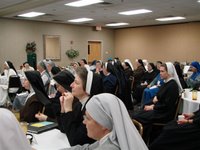
I strongly suggest spending time at the website of the
Council of Major Superiors for Women Religious (CMSWR), pictured at right. You will find a stark contrast in what is promoted at this site, versus the
Leadership Conference for Womens Religious (LCWR). The titles alone are very telling. One sees itself as a council of superiors from various communities. The latter sees itself as a conference for women's religious using the very business term, "leadership". Clicking through their site and viewing photos, it appears to be more like a business conference. Compare and contrast the kinds of communities profiled at each. Chances are, if you are reading this blog, you will identify with communities which fall within the CMSWR, rather than the LCWR.
If you have explored some communities through the CMSWR, please let us know about your experiences - anonymously or otherwise. As always, be charitable.
 You can read an Executive Summary of the report online (PDF), or you can purchase the entire report for $10.00 through the website of the Catholic Medical Association (click the image to get there).
You can read an Executive Summary of the report online (PDF), or you can purchase the entire report for $10.00 through the website of the Catholic Medical Association (click the image to get there).




